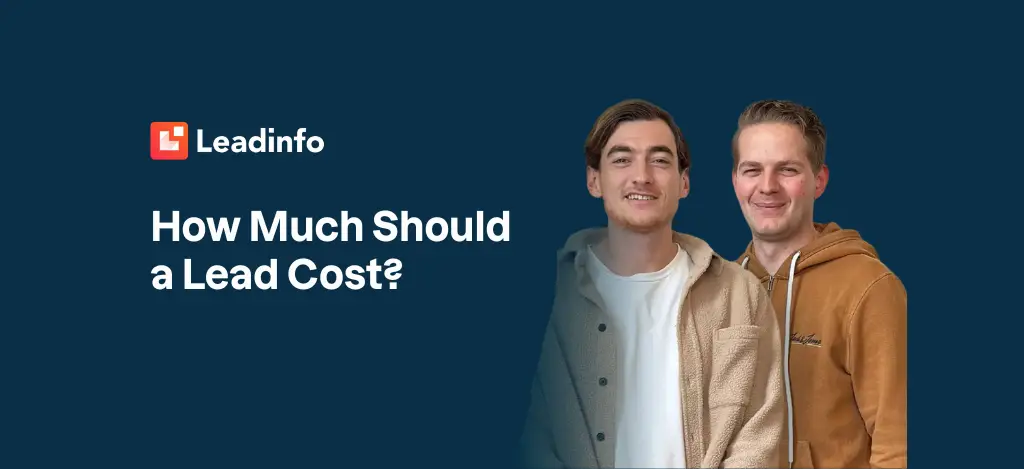In this blog, we walk you through the key insights so you fully understand how your own cost-per-lead (CPL) is calculated from start to finish.
The playing field is changing: B2B trends to keep in mind
Let’s start with a quick reality check. More and more decision-makers want to do their own research before speaking to a salesperson. At the same time, many organisations are seeing their marketing budgets fall by around ten per cent, while growth targets remain in place. Add to that the ongoing labour shortage, and it’s clear that every euro you invest in lead generation must deliver maximum return.
“From our experience, nine out of ten B2B marketers don’t know what an average lead may cost to still leave margin on the table. That’s a pity, because that’s exactly where huge optimisation potential lies.”
– Tim Meijer on the urgency of CPL insights
From prospect to customer: the four building blocks of a B2B funnel
To allocate budgets wisely, SDIM works with four inseparable building blocks. First, map out the customer journey: which touchpoints does a prospect encounter before they even consider a quote? Next, assign a financial value to each conversion moment. Then, define target groups—not only companies, but also individual roles within the decision-making unit (DMU). Finally, link relevant content to them. Only when these four elements are in place can you reliably work backwards to determine what a lead is worth.
Calculating cost per lead: start at the end and work backwards
In the webinar, Jesse from SDIM demonstrated how he always begins the calculation model at the revenue side. Suppose a new customer generates an average of €10,000 per year and you want to reinvest a maximum of ten per cent of that in acquisition. That leaves €1,000 to win a deal.
The next question: what percentage of your sales qualified leads (SQLs) actually convert into customers? If one in four does, an SQL may cost a maximum of €250. Then look at the conversion rate from marketing qualified lead (MQL) to SQL. If twenty per cent of your MQLs are picked up by sales, the maximum drops to €50 per MQL. Finally, divide that by the percentage of website visitors who convert at all. With a conversion rate of 2.5 per cent, you end up with a maximum click or visit price of €1.25.
“Always begin at the revenue side: first determine what one new customer is worth and what percentage of that you want to reinvest. Only then work step by step back from SQL to MQL to the click or visit price.”
– Jesse Wieleman on the calculation model
Crucially, this should not remain a theoretical table—you need to pull the percentages from your own data. In the webinar, Tim and Jesse translated this into three situations: a niche market with low volumes, a broad SaaS market with high volumes, and the typical mid-market company somewhere in between. In each case, the step percentages—and thus the allowable CPL—changed substantially.
Data as the foundation: what must be in place?
Calculations only work if the underlying data is reliable. The SDIM team highlighted three technical prerequisites:
- Complete tracking in GA4 or an alternative. Forms, downloads and phone calls must all count as conversions. Server-side tagging helps keep missed hits below ten per cent.
- A seamless link between Analytics and CRM. This can be surprisingly simple: use one anonymous identifier (not personal data!) stored both in your form and your CRM, such as a random field value or timestamp.
- Discipline in CRM. Even lost deals and dropped opportunities must be logged, because these are essential for calculating funnel percentages.
From raw numbers to clear insights: the Looker dashboard
To provide marketers and sales colleagues with the same single source of truth, SDIM built a Looker Studio report where revenue, costs, and funnel steps come together in real time. Jesse demonstrated live how he could instantly see that LinkedIn remarketing generated by far the most revenue, while a cold LinkedIn campaign was costly and rarely led to quotes.
By simply adjusting the date range and source filters, you immediately get answers to questions such as:
- Which channels deliver leads within our target CPL?
- Where do prospects drop off: between MQL and SQL, or only in the negotiation phase?
- What percentage of achieved revenue are we currently reinvesting, and does that stay within margin?
What does this mean for your organisation?
Once you master the CPL calculation, you hold a powerful steering tool in your hands. Marketing knows exactly how far it can go in ad auctions, sales can prioritise SQLs with the highest chance of success, and management sees how budgets translate into hard revenue. The model is also a living document: change your pricing, margin requirements, or conversion rates, and the threshold for what a lead may cost shifts automatically.
Get started
Curious about your own numbers? Rewatch the webinar, download the free dashboard template, and enter your own revenue, percentages, and costs step by step. Within an afternoon, you’ll not only know how much a lead may cost, but also which campaigns deserve extra budget tomorrow—and which should be cut back.
👉 Watch the webinar here. The webinar is recorded in Dutch, but you can use the subtitle feature to transcribe the webinar to English or other languages.
Meanwhile, would you like to see for yourself how Leadinfo turns your anonymous website visitors into concrete company profiles? Start your free 14-day trial today and immediately see which organisations are reading your content and which leads are ready for follow-up. Sign up within a minute via this link.


